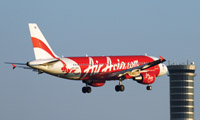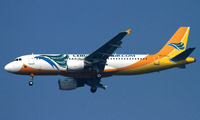20th Anniversary Issue: Low-Cost Carriers
LCCs prove their doubters wrong. And how !
These once brash upstarts are now an exciting and flourishing sector of the industry. Their operations have revolutionized flying in the Asia-Pacific and forced most of their legacy full-service rivals to join the club
October 1st 2013
It is difficult to appreciate that just 10 years ago there were many in the aviation industry who believed the future of budget airlines in the Asia-Pacific was limited - to say the least. Read More »
As Richard Stirland, then director general of the Association of Asia Pacific Airlines (AAPA) said in January, 2003, in an address to members of the Aerospace Forum Asia, in Hong Kong: “I would say - and I’m open to challenge on this - that [LCCs] don’t represent a threat to the so-called established carriers.
 |
| AirAsia: has pioneered the low-cost carrier market in Asia |
“In so far as Asia is concerned I can see little role or opportunity for them outside certain domestic markets, for example Australia and Japan.” Just how wrong could you be?
The region had one fast-growing LCC, Virgin Blue in Australia, wholly-owned by Richard Branson’s Virgin Atlantic Airways group at that time.
It was flying domestically after it made its first flight in August 2000, operating on one route with two aircraft. Within a year it had carried a million passengers and was about to benefit hugely from the impending collapse of Ansett Australia in late 2001.
In Asia, at the time of Stirland’s address, there was only one viable no-frills operator, Malaysia’s AirAsia, which was still in its fledgling phase of growth. It began operations as an LCC in 2001.
Originally a full service operator, the failing carrier was sold for the nominal sum of one ringgit (about US$0.26 at the time) to flamboyant former Time Warner music executive, Tony Fernandes, and his company, Tune Air.
That deal, unimportant as it seemed at the time and cheap as it was, marked the real birth of low-cost airlines in the Asia-Pacific.
With a paltry regional market share of less than 1% early in the new millennium, incumbent legacy airlines regarded the LCCs as little more than an irritation, an insect bite.
Today, LCCs share of the passenger market is around 30%, with forecasts that within the next decade they will hold more than 50%.
There are 45 LCCs in the region. Between them, major operators such as AirAsia, Indonesia’s Lion Air, Jetstar, tigerair and Cebu Pacific have more than 1,000 single-aisle jets on order.
In the Philippines, Cebu is now the country’s largest operator. At the major hub of Singapore Changi International Airport, LCC traffic accounts for 25% of business. In Thailand, more than 30% of traffic at the six main airports is no-frills.
In recent times, budget carriers have been pushing into new markets once seen as no-go areas, such as Japan, Hong Kong and China.
Their story is one of innovation, risk-taking and success. Along the way they have changed the rules, not only for themselves, but for the region’s full-service carriers. The ‘big boys’ have had to make significant adjustments to meet the challenge in markets they once dominated.
All of the major operators – apart from Cathay Pacific Airways and Air New Zealand – have their own LCC offshoots. The pattern began in 2003 when Qantas Airways did what the pundits forecast would be an abject failure, launching Jetstar as a low-cost domestic subsidiary to compete with the then budget carrier, Virgin Blue.
Attempts by legacy airlines in Europe and North America – where LCCs such as Southwest, Ryanair and easyJet had been operating since the 1970s and 1980s – to operate their own budget subsidiaries had all failed.
But Jetstar, led by Alan Joyce, now Qantas chief executive, was a roaring success. It began international flying in 2005. There are now Jetstar subsidiaries in Singapore, Vietnam, Japan and (given regulatory clearance) Hong Kong.
It has become a trend. AirAsia has subsidiaries in Thailand, Indonesia, the Philippines, is set to launch in India and re-launch in Japan after its joint venture, AirAsia Japan, with All Nippon Airways, failed earlier this year.
Even Singapore Airlines, regarded as a conservative legacy operator, followed suit with a major stake in Tiger Airways, now tigerair, established in 2004. Its stable includes tigerair Australia (60% owned by Virgin Australia), tigerair Philippines and tigerair Mandala in Indonesia.
One of the key factors for the major LCC groups’ success has been their ability to sidestep traditional national ownership rules. They have done this by setting up regional subsidiaries in joint ventures with majority local shareholders, giving them critical entry into wider local and regional markets.
They broke the mould in other ways. AirAsia launched a long-haul subsidiary, AirAsia X, using widebody aircraft to fly to destinations far beyond the reach of the traditional low-cost, single-aisle model.
Cebu Pacific and Lion Air are entering the long-haul budget space, as has Singapore Airlines with its offshoot Scoot. Jetstar is venturing further, too, and is expected to extend these operations as it takes delivery of 14 B787 Dreamliners and revises its international network to suit the Dreamliner.
The road hasn’t always been easy, but it has had its inspirational moments. Fernandes, the tireless chief of the AirAsia Group, has both annoyed and attracted admiration from his rivals as he built his regional empire, taking risks and breaking new ground.
In the Philippines, Lance Gokongwei, at 29, and a graduate in engineering and finance from Pennsylvania University, was handed a small and ageing fleet of B757s and McDonnell Douglas DC-9s by his father John, the country’s third richest man, and told: go run an airline.
John Gokongwei, then 85 years old, had bought Cebu Pacific in 1995 following a failed bid for a stake in Philippine Airlines (PAL). While it made profits and captured 30% of the domestic market it was badly hit by the SARS crisis in 2003 and rising fuel prices in 2004.
That’s when Lance had his eureka moment and took the decision to turn it into a true low-cost carrier, ordering a fleet of A320s. By 2010, it was the market leader in the Philippines, overtaking PAL in passenger numbers.
In China, where aviation is highly regulated, Spring Airlines began domestic operations in July 2005 and launched its first international route, from Shanghai to Japan’s Ibaraki airport, about 80 kilometres from Tokyo, in July, 2010. It plans to launch Spring Japan in May next year, offering domestic services from Tokyo’s Narita airport.
The region is now riddled with no-frills offerings. Thailand has Nok Air, majority owned by Thai Airways International, Thai AirAsia and Orient Thai, with Vietnamese LCC, Vietjet, in the process of setting up a Thai subsidiary.
 |
| Cebu Pacific: now the leading domestic carrier in the Philippines and expanding internationally |
Korea has T’way Airlines, Jeju Air, Jin Air, EastarJet and Air Busan. In the Philippines, along with Cebu there is PAL LCC subsidiary, AirPhil Express, Zest Airways and SEAIR, or South East Asian Airlines.
India’s often chaotic airline scene has been an arena for fierce LCC action. Budget operators include Air India Express, IndiGo, Go Air, Jet Lite and Spicejet.
In Japan, LCCs have been slow to take off although a number of “low operating cost”, hybrid ventures were launched in the late 1990s and early 2000s. These included Air Do, often described as Japan’s first low-cost carrier (it was absorbed by ANA in 2000), Skymark Airlines, Solaseed Air and StarFlyer.
In reality, they are not true LCCs and have faced major problems winning sufficient slots at Japan’s congested major airports to establish passenger loyalty. True LCCs began arriving last year with the launch of Jetstar Japan and Peach Aviation (part-owned by ANA). AirAsia Japan (part-owned by ANA), will cease operations on October 31 and is to be replaced by a new wholly-owned ANA LCC, Vanilla Air.
Not surprisingly, there have been other failures along the way. India’s first no-frills operator, Air Deccan, ran into financial trouble and was taken over by Kingfisher Airlines, which re-named it Kingfisher Red. It, in turn, went out of business.
Indonesia’s Batavia Air collapsed in January. In Hong Kong, an attempt to launch a long-haul LCC, Oasis Hong Kong Airlines, also failed. It launched services using B747s to London in 2007 and then Vancouver. In April 2008 it was announced the carrier was ceasing operations after suffering an accumulated loss of $128 million.
All in all, the rapid growth of budget flying in Asia-Pacific has been a major part of the region’s ongoing economic success, bringing air travel to many who couldn’t previously afford it, as well as directly linking many destinations that were once off the airline map.
Their presence hasn’t put legacy airlines in jeopardy. It has helped change the mindset of network carriers.
Full-service operators have learnt from the budget players, such as increasing their ancillary revenue streams by charging for extras like paying a fee for a particular seat on a plane.
What the naysayers didn’t seem to realise, as LCCs began to emerge in the Asia-Pacific, was that tens of millions of people in the region wanted exactly the same travel opportunities as everyone else in the world: cheaper travel options and more places to visit.